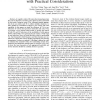236 search results - page 24 / 48 » Model of primary and secondary context |
CORR
2010
Springer
13 years 5 months ago
2010
Springer
We consider an opportunistic spectrum access (OSA) problem where the time-varying condition of each channel (e.g., as a result of random fading or certain primary users' activ...
IEEEPACT
2008
IEEE
14 years 5 months ago
2008
IEEE
One of the essential features in modern computer systems is context switching, which allows multiple threads of execution to time-share a limited number of processors. While very ...
ICC
2007
IEEE
14 years 5 months ago
2007
IEEE
—This paper addresses context issues in pervasive mobile computing and presents a semantic context model to support location based cooperative mobile applications. In this paper,...
ICC
2011
IEEE
12 years 10 months ago
2011
IEEE
—In cognitive radio (CR) networks, licensed spectrum that can be shared by secondary users (SUs) is always restricted by the needs of primary users (PUs). Although channel aggreg...
ISMB
2004
14 years 7 days ago
2004
Motivation: Non-coding RNAs (ncRNAs)--functional RNA molecules not coding for proteins--are grouped into hundreds of families of homologs. To find new members of an ncRNA gene fam...

